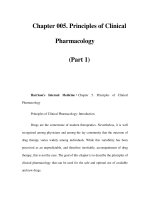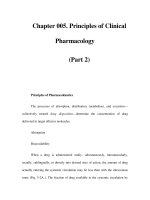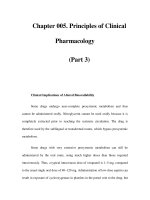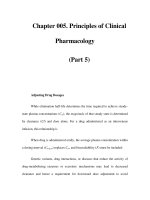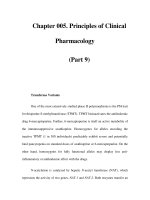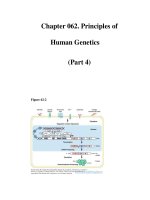Chapter 081. Principles of Cancer Treatment (Part 18) pps
Bạn đang xem bản rút gọn của tài liệu. Xem và tải ngay bản đầy đủ của tài liệu tại đây (54.19 KB, 5 trang )
Chapter 081. Principles of
Cancer Treatment
(Part 18)
Site of action of targeted agents. Signals proceeding from growth factor–
related receptor tyrosine kinases (RTKs) such as EGF-R, erbB2, or c-kit can be
interrupted by lapatinib, erlotinib, gefitinib, and imatinib, acting at the ATP
binding site; or by cetuximab, trastuzumab, or panitumomab. Tyrosine kinases
(TKs) that are not directly stimulated by growth factors such as p210 bcr-abl or src
can be inhibited by imatinib, dasatinib, or nilotinib. Signals projected downstream
from growth factor receptors can be affected by the multitargeted kinase inhibitor
sorafenib, acting on c-raf, and, upon arrival at the nucleus, affect gene expression,
which can be affected by the targeted transcriptional modulators vorinostat
(targeting histone deacetylase), azacytidine derivatives (targeting DNA
methyltransferase), or retinoid receptor modulators all-trans-retinoic acid (ATRA)
or bexarotene. Cytokine receptors (CkRs) are one stimulus for degradation of the
inhibitory subunit of the NFκB transcription factor by the proteosome. Bortezomib
inhibits this process and can prevent activation of NFκB-dependent genes, among
other growth-related effects. Sorafenib and sunitinib, acting as inhibitors of VEGF
receptors, can modulate tumor blood vessel function through their action on
endothelial cells, while bevacizumab targets the same process by combining with
VEGF itself.Hematopoietic Neoplasms
Imatinib targets the ATP binding site of the p210
bcr-abl
protein tyrosine
kinase that is formed as the result of the chromosome 9,22 translocation producing
the Philadelphia chromosome in CML. Imatinib is superior to interferon plus
chemotherapy in the initial treatment of the chronic phase of this disorder. It has
lesser activity in the blast phase of CML, where the cells may have acquired
additional mutations in p210
bcr-abl
itself or other genetic lesions. Its side effects are
relatively tolerable in most patients and include hepatic dysfunction, diarrhea, and
fluid retention. Rarely, patients receiving imatinib have decreased cardiac
function, which may persist after discontinuation of the drug. The quality of
response to imatinib enters into the decision about when to refer patients with
CML for consideration of transplant approaches. Nilotinib is a tyrosine protein
kinase inhibitor with a similar spectrum of activity to imatinib, but with increased
potency and perhaps better tolerance by certain patients. Dasatinib, another
inhibitor of the p210
bcr-abl
oncoproteins, is active in certain mutant variants of
p210
bcr-abl
that are refractory to imatinib and arise during therapy with imatinib or
are present de novo. Dasatinib also has inhibitory action against kinases belonging
to the src tyrosine protein kinase family; this activity may contribute to its effects
in hematopoietic tumors and suggest a role in solid tumors where src kinases are
active. Only the T315I mutant is resistant to dasatinib; a new class of inhibitors
called aurora kinase inhibitors is in development to address this problem.
All-trans-retinoic acid (ATRA) targets the PML-retinoic acid receptor
(RAR) α fusion protein, which is the result of the chromosome 15,17 translocation
pathogenic for most forms of APL. Administered orally, it causes differentiation
of the neoplastic promyelocytes to mature granulocytes and attenuates the rate of
hemorrhagic complications. Adverse effects include headache with or without
pseudotumor cerebri and gastrointestinal and cutaneous toxicities. Another active
retinoid is the synthetic retinoid X receptor ligand bexarotene, which has activity
in cutaneous T cell lymphoma.
Bortezomib is an inhibitor of the proteasome, the multi-subunit assembly of
protease activities responsible for the selective degradation of proteins important
in regulating activation of transcription factors, including NFκB and proteins
regulating cell cycle progression. It has activity in multiple myeloma and certain
lymphomas. Adverse effects include neuropathy, orthostatic hypotension with or
without hyponatremia, and reversible thrombocytopenia.
Vorinostat is an inhibitor of histone deacetylases, responsible for
maintaining the proper orientation of histones on DNA, with resulting capacity for
transcriptional readiness. Acetylated histones allow entry of transcription factors
and therefore increased expression of genes that are selectively repressed in
tumors. The result can be differentiation with the emergence of a more normal
cellular phenotype, or cell cycle arrest with expression of endogenous regulators
of cell cycle progression. Vorinostat is approved for clinical use in cutaneous T
cell lymphoma, with dramatic skin clearing and very few side effects.
DNA methyltransferase inhibitors including 5-aza-cytidine and 2'-deoxy-5-
azacytidine can also increase transcription of genes "silenced" during the
pathogenesis of a tumor by causing demethylation of the methylated cytosines that
are acquired as an "epigenetic" (i.e., after the DNA is replicated) modification of
DNA. These drugs were originally considered antimetabolites but have clinical
value in myelodysplastic syndromes and certain leukemias when administered at
low doses. Combinations of DNA methyltransferase inhibitors and histone
deacetylase inhibitors may offer new approaches to reregulate chromatin function.
Targeted toxins utilize macromolecules such as antibodies or cytokines
with high affinity for defined tumor cell surface molecules, such as a leukemia
differentiation antigen, to which a therapeutic antibody can deliver a covalently
linked potent cytotoxin (e.g., gemtuzumab ozogamicin, a drug linked to anti-
CD33), or a growth factor such as IL-2 to deliver a toxin (in the form of diphtheria
toxin in denileukin diftitox) to cells bearing the IL-2 receptor. The value of such
targeted approaches is that in addition to maximizing the therapeutic index by
differential expression of the target in tumor (as opposed to nonrenewable normal
cells), selection of patients for clinical use can capitalize on assessing the target in
the tumor.
